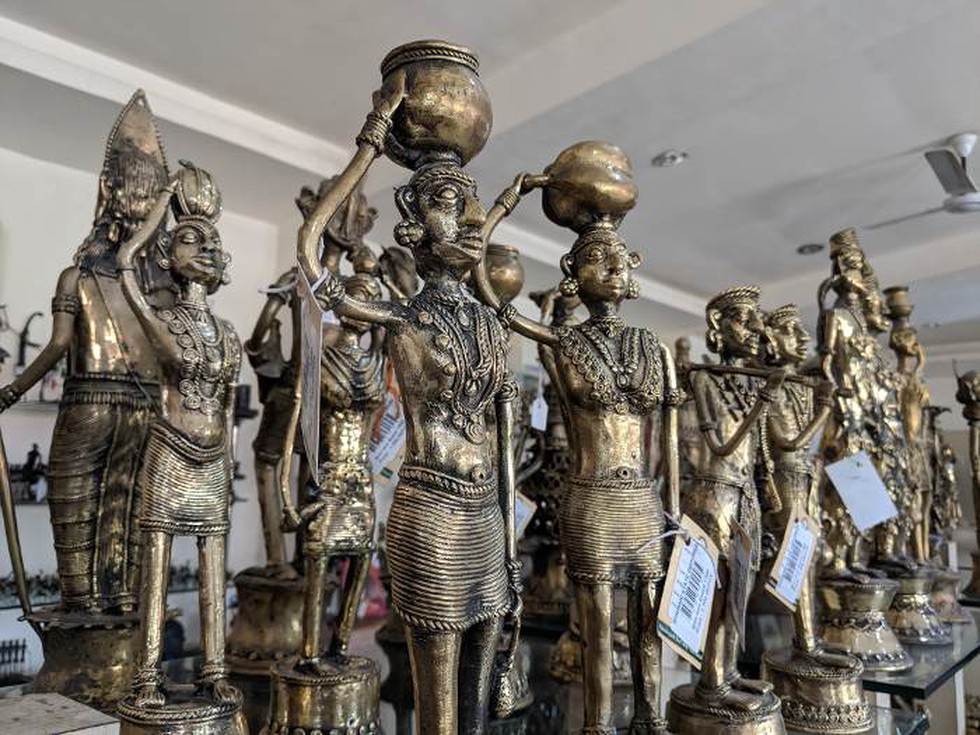Nestled within the rich cultural tapestry of India lies a tradition that dates back over 4,000 years, embodying the essence of artistic expression and craftsmanship. Dhokra Shilpkala, often hailed as one of the oldest known methods of metal casting, holds a special place in the heart of Indian heritage. This ancient technique, originating from the tribal communities of India, continues to captivate art enthusiasts worldwide with its intricate designs and unparalleled craftsmanship.
What is Dhokra Shilpkala?
Dhokra Shilpkala involves an intricate process of metal casting, using the lost-wax technique. Artisans meticulously craft patterns and designs in beeswax, which are then encased in a clay mold. The wax is melted away, leaving behind a mold into which molten metal is poured, resulting in exquisite artifacts ranging from figurines and jewelry to functional items.
Origins and Cultural Significance
The origins of Dhokra Shilpkala can be traced back to the tribal communities residing in the regions of Chhattisgarh, Jharkhand, West Bengal, and Odisha, where it evolved as an integral part of their cultural and religious practices. The word “Dhokra” is believed to be derived from the Dhokra Damar tribes, who are the traditional metal smiths of Central India. Its history is deeply intertwined with the daily lives, rituals, and beliefs of the tribal communities, making it not just a craft but a way of life.
Technique and Process of Dhokra Shilpkala
What sets Dhokra Shilpkala apart is its remarkable technique of metal casting, which involves using the lost wax casting method, also known as cire perdue. The process begins with the creation of a clay core, which serves as the base for the final metal sculpture. Artisans then coat this clay core with a layer of beeswax, meticulously sculpting the intricate designs and patterns by hand.
Once the wax model is complete, it is covered with layers of clay, forming a mold around the wax pattern. The entire structure is then heated, allowing the wax to melt and drain out, leaving behind a cavity in the shape of the original sculpture. Molten metal, typically a combination of brass and bronze, is poured into this cavity, filling the space left by the melted wax. After cooling and solidifying, the clay mold is broken away, revealing the final metal casting.
Artistic Expression and Diversity
The beauty of Dhokra Shilpkala lies in its rustic charm and the organic nature of its designs. Artisans draw inspiration from nature, mythology, and everyday life, incorporating motifs such as animals, birds, deities, and tribal symbols into their creations. Each piece exudes a sense of timeless elegance and cultural richness, reflecting the heritage and traditions of the artisans.
From miniature figurines and jewelry to larger-than-life sculptures and functional objects, Dhokra Shilpkala encompasses a wide range of artistic expressions. The versatility of this craft allows artisans to experiment with different forms, sizes, and finishes, ensuring that each piece is unique and carries a story of its own.
Challenges and Preservation Efforts
Despite its rich history and cultural significance, Dhokra Shilpkala faces numerous challenges in the modern world. The rapid pace of urbanization, coupled with the rise of mechanized production techniques, has threatened the livelihoods of traditional artisans and endangered this ancient craft. However, efforts are underway to preserve and revive Dhokra Shilpkala, both at the grassroots level and through government initiatives and non-profit organizations.
Artisan cooperatives and craft clusters have been established to provide support and resources to skilled craftsmen, enabling them to sustain their craft and pass it on to future generations. In an initiative to safeguard Dhokra Shilpkala, entrepreneurs like Nisha Bothra have taken the initiative to preserve the cultural heritage by founding studios that blend traditional art forms with contemporary aesthetics.
Multiple Choice Questions (MCQs):
- What is the primary material used in Dhokra Shilpkala?
a) Clay
b) Beeswax
c) Metal
d) Wood
Answer: b) Beeswax - Which technique is employed in the metal casting process of Dhokra Shilpkala?
a) Sand casting
b) Investment casting
c) Lost-wax casting
d) Die casting
Answer: c) Lost-wax casting - Which regions of India are associated with the origins of Dhokra Shilpkala?
a) Maharashtra and Gujarat
b) Kerala and Tamil Nadu
c) Chhattisgarh, Jharkhand, West Bengal, and Odisha
d) Punjab and Haryana
Answer: c) Chhattisgarh, Jharkhand, West Bengal, and Odisha - What is the significance of the word “Dhokra” in Dhokra Shilpkala?
a) It means “craftsmanship” in Sanskrit
b) It refers to a type of metal alloy
c) It is derived from the name of the tribal community associated with the craft
d) It signifies “precious art” in the local dialect
Answer: c) It is derived from the name of the tribal community associated with the craft - What challenges does Dhokra Shilpkala face in the modern world?
a) Declining demand for handmade crafts
b) Threat of extinction due to urbanization and mechanization
c) Lack of skilled artisans
d) All of the above
Answer: d) All of the above
